It’s time to untangle your nets and set out to sea: the market will be open soon, and people will be lining up to buy some seafood. Come see why Isaribi is the catch of the day.
At a glance: Isaribi is a game by Hisashi Hayashi for 3 to 5 players, ages 10 and up, and takes about 45 minutes to play. It was originally published in Japan by Okazu Brand, and Eagle-Gryphon Games is running a Kickstarter campaign now to bring it to the US, with a pledge of $29 for a copy of the game. Isaribi is about fishing in medieval Japan, and managing your actions to catch fish, sell them at the market, and improve your boat and nets. Based on the complexity of the game, I think 10 and up is about right, but there’s nothing in the theme or content that would prevent it from being appropriate for younger players—mostly it’s about planning ahead.
New to Kickstarter? Check out our crowdfunding primer, and visit our curated page for more projects we love.

Components
- 1 Harbor/Market board
- 1 Treasury board
- 82 cards:
- 29 Fish cards (6 Clam, 8 Prawn, 8 Mackerel, 7 Sea Bream)
- 32 Market cards
- 5 Fishing Boat cards
- 10 Special Ability cards (5 each Smokehouse and Client)
- 5 Collaborator cards
- 1 Start Player pawn
- 80 Seafood cubes (20 each in four colors)
- 10 Ability tokens
- 5 Fishing Boat pawns
- 5 Money tokens
- 1 Round marker
My review is based on a prototype, so some of the components pictured may change—for instance, my fishing boats were discs instead of boat-shaped—and this is also not reflective of the final quality of the components.
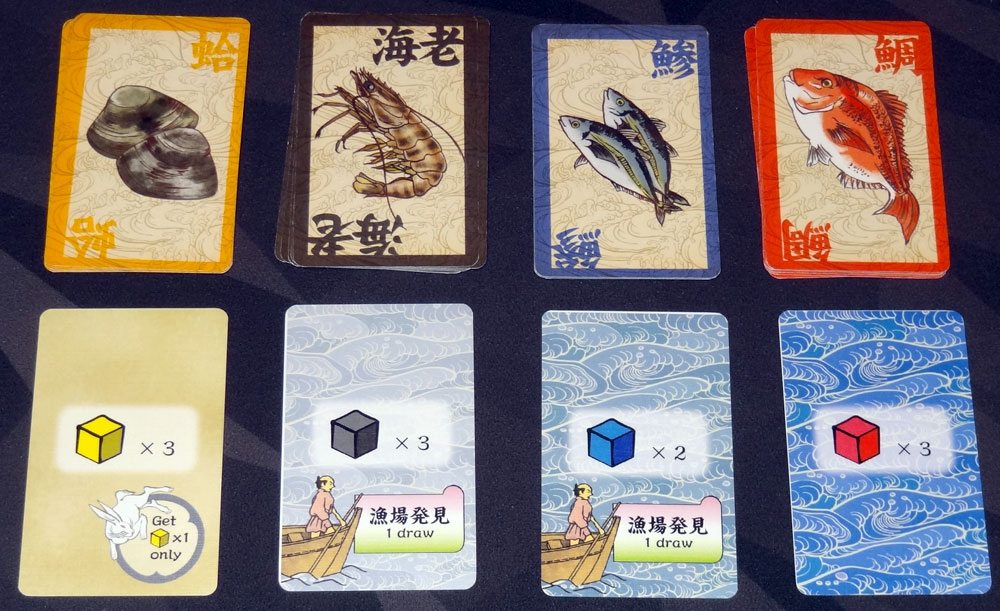
The overall look of the game is nice, though there are some things that seem kind of odd. For instance, the clam cards have a little reminder text that you can only catch 1 at a time (“Get x1 only”)—and next to that is a picture of a rabbit. Maybe it represents speed? I’m not entirely sure, but it feels a little inexplicable and reminds you that this is a game that was translated from another language and another culture. At the same time, I kind of like that these things will be preserved from the Okazu Brand version.
The cards are, for the most part, easy to interpret: fish cards have a color cube and a number, indicating how many of that cube to put on the card; market cards have cubes in the top corner showing how many and what type of fish a customer will buy, and coins in the bottom corner showing how much the customer will pay for those.
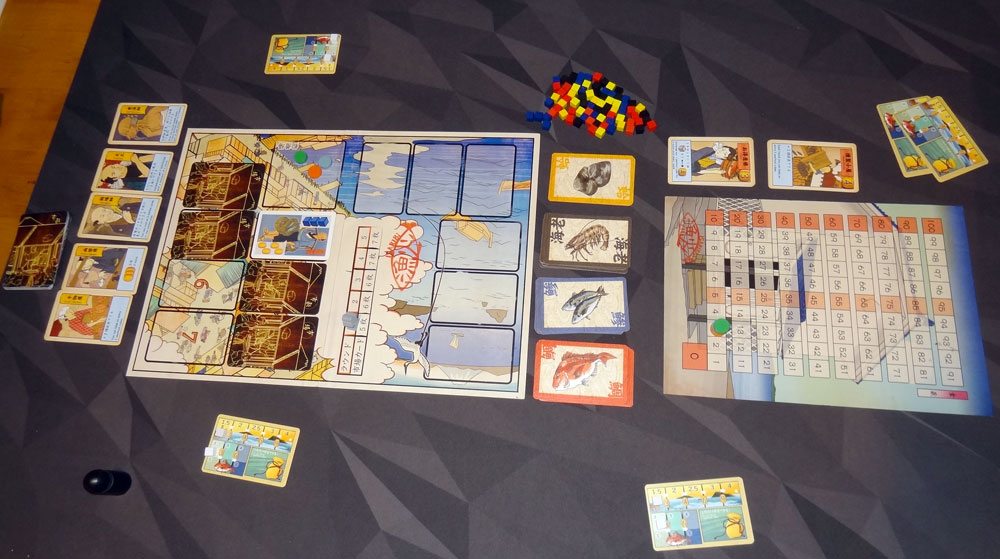
How to Play
The rules (from the Okazu version) are available as a PDF.
The goal of the game is to have the most money at the end of 5 rounds.
To set up, each player takes a fishing boat card, 2 ability tokens, and the fishing boat pawn and money token of their color. The harbor/market board and the treasury board are placed in the center of the table. Each player’s money token is placed on “3” on the treasury board. The ability tokens are placed on the fishing boat card: one at the left end of the top row, representing your boat, and one at the left end near the bottom, representing your nets. The collaborator cards and two types of special ability cards are placed near the board. The fish cards are shuffled in their separate decks and placed near the board, as are the market cards. Choose a player to be first player and give them the start player pawn. Place the round marker on Round 1.
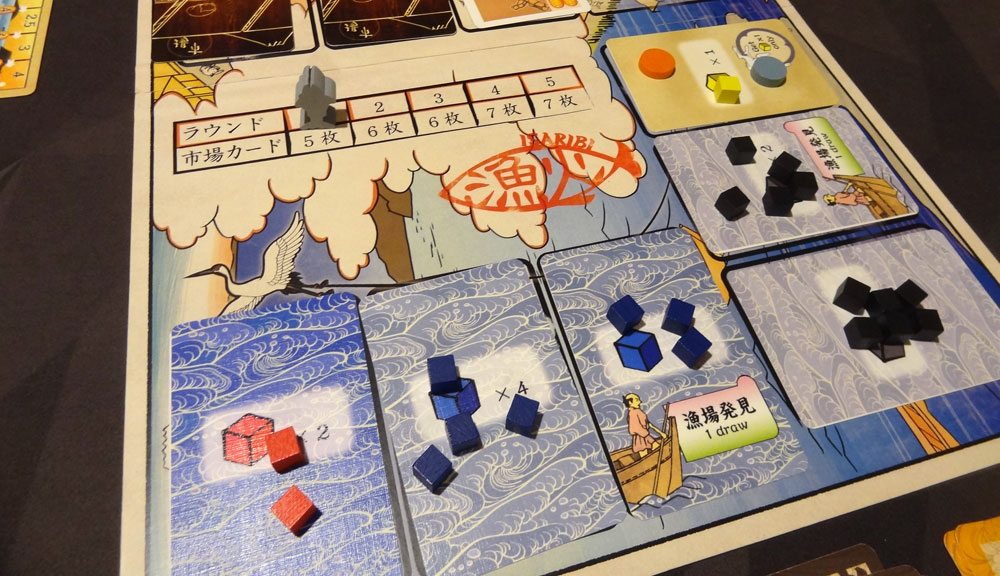
At the start of each round, deal out a number of market cards face-down on the market board, dependent on the round number, and then turn the first market card face-up. Then add fish cards face-up to the sea in the order: clam, prawn, mackerel, sea bream. Some of the prawn and mackerel cards tell you to draw an additional card of that type, but you would draw a maximum of two cards of any given type. Each fish card shows a number of cubes: add that many cubes to that space in the sea. Then, once the fish are placed, everyone in turn order places their fishing boat pawn either in the harbor (next to the market cards) or in the first sea space (where the clams are).
Each time it would be the start player’s turn (except the first turn), the next market card is revealed. This happens even if the first player has already passed and is taking no more actions this round.
A round consists of many turns and continues going around the table until every player has passed. A player’s turn may consist of multiple actions, or you may pass—but once you have passed, you have no more turns until the following round begins.

On your turn, you look at your fishing boat card—the top row shows how many action points (AP) you have for this turn. (At the beginning of the game, you start with 1.5 AP per turn.) Here are the actions you may perform: Move, Fish, Sell, Gain Technology, Reveal Market Card. You may spend as much of your AP as you wish per turn; unspent AP is lost and does not carry over.
Move: You may move your boat any number of spaces out to sea or back toward the harbor, at a cost of 1 AP per move.
Fish: You may only fish once per turn, either by hand (.5 AP) or by net (1 AP). Fishing by hand lets you take 1 cube from the sea space where your boat is. Fishing by net lets you take a number of cubes according to your net’s value (shown on your fishing boat card). Note that clams may only be caught by hand, and sea bream must be caught by nets.
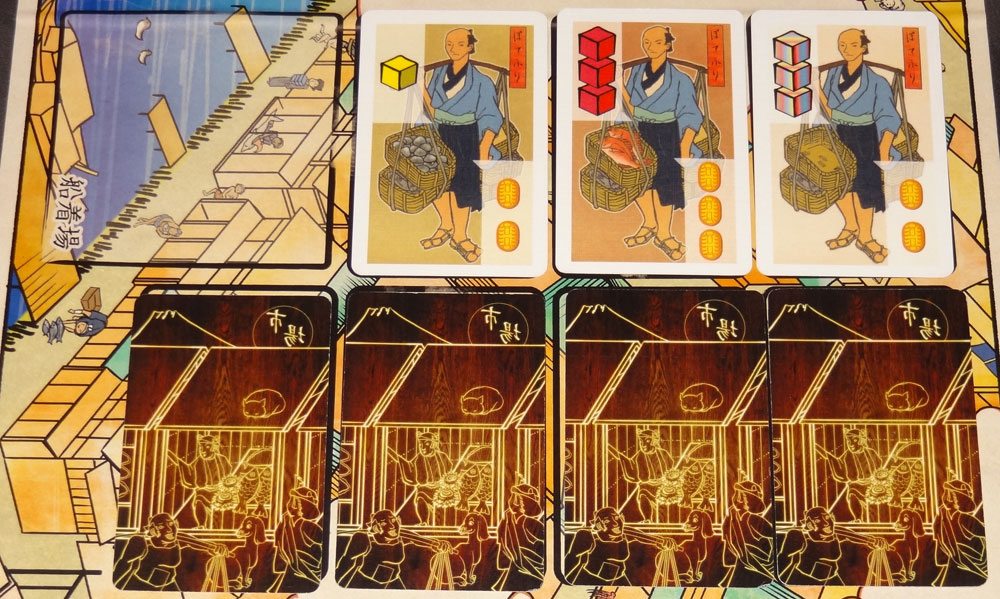
Sell: You may only sell once per turn, either a retail sale (.5 AP) or gross sale (1 AP), and you must be in the harbor to make a sale. A retail sale is 1 cube to 1 market card; a gross sale lets you sell to up to 2 market cards, up to 2 cubes per card. The cubes you sell must match the market card, and the card shows how much money you get per cube. Rainbow markets will buy any type of fish. Once a card has as many cubes as are depicted on the card, it will no longer buy any more fish.
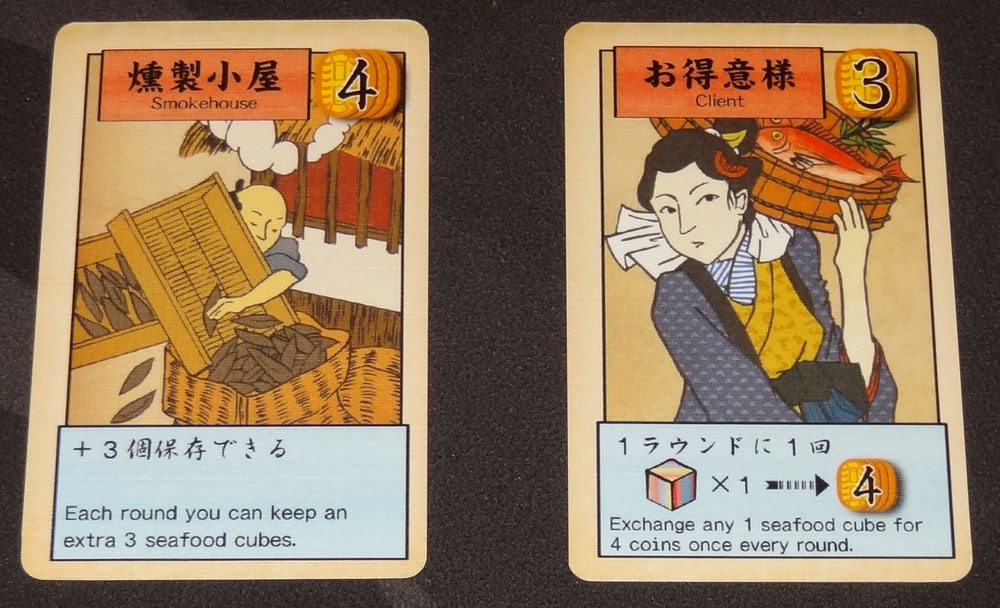
Gain Technology: You may only gain technology once per turn, and only in the harbor, for 1 AP. You may improve your boat, your nets, or buy a special ability. The cost to improve your boat or net is shown on your fishing boat card: pay the amount, and then move the ability cube to the right. To buy a special ability, pay the amount shown on the card and place the card in front of you. You may only have one of each special ability card.
- Smokehouse: You may keep an additional 3 fish cubes at the end of the round without spoiling.
- Client: You may treat this as a market card which will buy 1 of any type of fish for 4 coins.
Reveal Market Card: You may reveal any number of market cards per turn at the cost of 1 AP per card, regardless of where your boat is. You must reveal them in order.

If you decide to pass and take no actions, you claim the start player pawn and also take one of the collaborator cards. (Note that the first player may not be first player again—if they’re the first one to pass, the player to their right takes the pawn instead.) Here are the five collaborator cards:
- Old Fisherman: After everyone has placed their boats, pick a sea space and add 3 more fish cubes (of that type) to that card.
- Dried Fish Shop: you may keep an additional 2 fish cubes at the end of this round without spoiling.
- Carpenter: gain 1 technology immediately, at a discount of 3 coins.
- Speculator: At the beginning of the next round, you may look at 3 face-down market cards before everyone places their boats.
- Money Changer: get 3 coins immediately.
The collaborator cards are one-time use, and are returned to the center of the table to be selected again for the next round.
At the end of the round, once everyone has passed, check to see if any fish spoil—typically you may only keep one fish cube in your boat, but the smokehouse and dried fish shop let you keep more. If you have more than you can keep, the rest spoil (and are put back into the supply), and you must pay a 3-coin fine (total, regardless of number of fish spoiled). Then the next round begins.
After five rounds, the game ends, and the player with the most money wins.
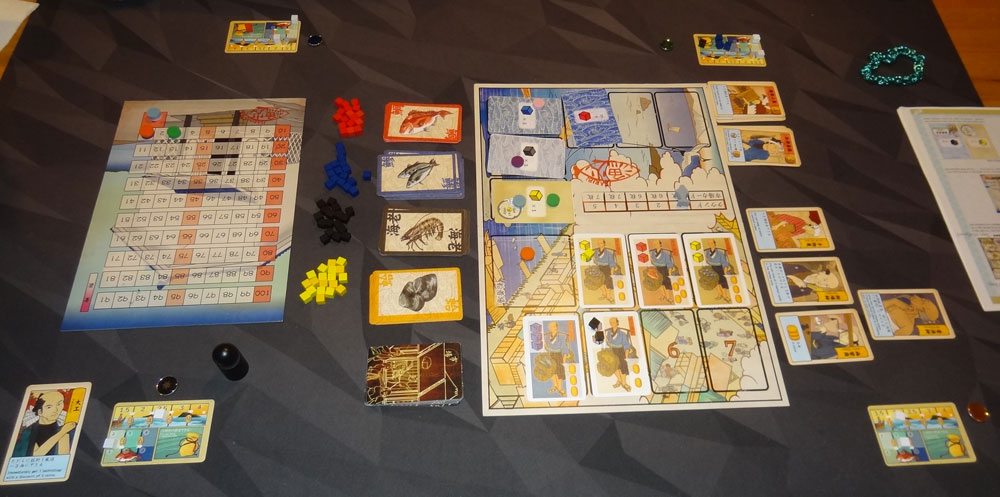
The Verdict
Isaribi is a pretty fascinating game that’s all about the trade-offs. You only have so many actions per turn, and so you spend a lot of time thinking about not just the monetary cost of things, but the opportunity costs. Do you start off in the harbor, where you can improve your boat (and get more actions for future turns), or do you go straight out to sea, hoping to get a head start before everything is fished out? Do you sell your catch to the first customer who will buy them, or do you use up some of your precious actions flipping over market cards to see if you can get a better deal?
The gameplay itself is not that complex (though the half-point actions are a little unconventional), but it leads to a lot of deliciously difficult decisions to make—and all of them depend heavily on what your opponents are doing. The ideal, of course, is to catch just the right number and type of fish so that you can get to market, sell to the highest bidder, and have nothing that spoils (which costs you money). But, of course, there are other fishermen out there: any one of them might take the last fish from a location, or sell to the customer before you got a chance, or take the Dried Fish Shop so that you’re left with extra fish in your boat at the end of the round. It’s important to know where your opponents are, what fish they have in their boats, and how many actions they’re going to get each turn.
Of course, even if you know your opponents, you may not know the market. Since the market cards are usually revealed one per round (unless somebody spends actions to reveal them earlier), it’s hard to know for sure what type of fish you should be catching. In general, the fish get more valuable as you get further out to sea—but only if there’s somebody willing to buy them. Buying a smokehouse so that you can keep extra fish for the next round can be a good investment, particularly if you can start a round ready to sell. The Speculator collaborator card can also be very powerful, giving you some insider knowledge about which customers will be arriving later in the round—but, of course, you still have to be able to catch those fish and get them to the market at the right time in order to profit from that foreknowledge.
Since the final score is based on money, there’s also the trade-off between buying technology and keeping your money. After all, you have to spend money to make money, right? Well, sort of. All of the technologies can be very valuable: improving your boat gives you more actions each turn, and improving your net lets you catch more fish per action. The client gives you one guaranteed sale at a pretty good price, and the smokehouse helps you avoid those spoilage penalties. But judging how much money each of these improvements will earn you over the course of the game is very tricky—certainly the earlier you buy something, the better, but at the start of the game you only have 3 coins, so you can’t even buy much until you make some sales. It was typical for the scores to fluctuate at very low levels for the first few rounds, as most of the players made money and then spent it. Later in the game, though, it feels too late to buy things because you won’t get enough benefit from them.
Improving your boat tends to be sort of an arms race. If nobody else does it, then you all have the same number of actions, so it doesn’t matter as much. But if one player gets ahead, they will have a small advantage that accumulates each turn they take. A player with enough actions can potentially catch fish, move, and sell them, all in a single turn.
The other big trade-off in the game comes in deciding when to pass. The sooner you pass, the more options you have for choosing a collaborator, but it means giving up any other actions you could have accomplished this round. At some point, the entire sea will be fished out, all of the market cards will be revealed, and any sales that are possible will have been made—if you wait until then, everyone will be passing and there might not be anything left for you. The Carpenter, allowing you to get a technology at a discount, can be quite powerful, particularly if you use it to get an extra boat upgrade early in the game. Sometimes that Dried Fish Shop is a necessary choice, whether because other people beat you to market or because, hey, nobody was interested in buying mackerel this round. I’ve even seen somebody who didn’t have any extra fish take the Dried Fish Shop, just to ensure that another player had to figure out what to do with their extra fish: buy a smokehouse, or pay the spoilage penalty.
I really liked the interplay of decisions in Isaribi. There’s plenty of player interaction, even though you can’t directly affect other players. There’s nothing you can do to take away somebody’s fish or money, but there are plenty of ways that you can interfere with somebody’s plans—and, of course, plenty of ways they can interfere with yours. Even when nobody is actively working against you, there are still some tough calls you’ll have to make. Yet the game itself is not that difficult to learn, and will not feel overwhelming to most gamers. I also liked the fishing theme: it’s not one that has been overdone, but it also feels familiar—even if you don’t fish, the process in the game makes intuitive sense.
If you’re looking for a fun game about fishing (and managing your time and money well), take a look at Isaribi—it’s a keeper. Visit the Isaribi Kickstarter page for more information or to make your pledge.





